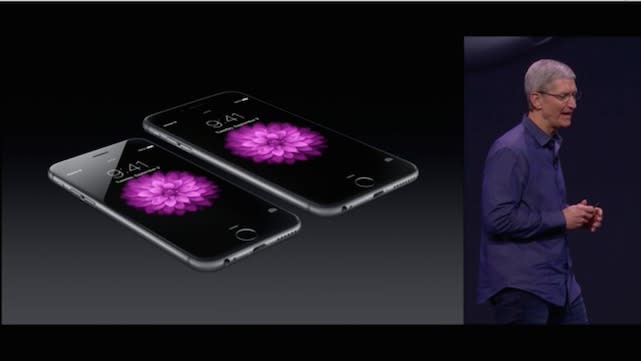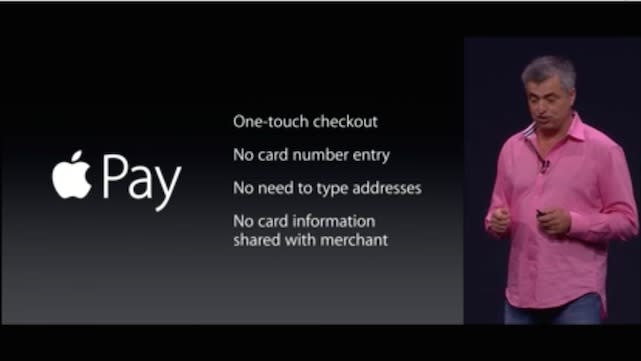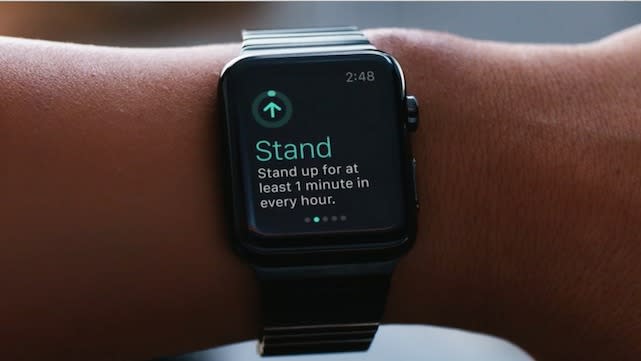Summarizing Apple's iPhone 6 / Watch event

Despite glitches during Apple's livestream of today's event, most of us here at TUAW were able to pick up enough of what was going on to realize immediately just how significant most of the announcements were. Here's a quick summary of some of the topics we found to be the most important:
iPhone 6 / iPhone 6 Plus
The Apple team spent no time warming up, jumping right into the announcement of the two new iPhone models immediately. The iPhone 6 and iPhone 6 Plus will both be available on September 19, with pre-ordering starting this Friday, September 12. Prices start at US$199 for the 16GB iPhone 6 (64GB and 128GB versions available for $299 and $399 respectively), while the 16GB iPhone 6 Plus starts at $299 (64 GB for $399 and 128GB for $499).
Both phones feature a new CPU -- the Apple-designed A8 -- and a new motion coprocessor called the M8. The M8 builds upon the motion-sensing and capturing capabilities of the M7 in the iPhone 5 family by adding a barometer sensitive enough to tell the relative height changes you take climbing a hill or even just going up and down stairs. The A8 features 2 billion transistors, but is 13 percent smaller than the A7 that featured just 1 billion. The company says that the CPU power of the iPhone 6 is about 50 times that of the original iPhone introduced in 2007.

The design of the new phones includes ion-strengthened glass, an improved polarizer, a photo-aligned IPS liquid crystal display, and an ultra-thin backlight. The screen size of the iPhone 5 family is 4 inches measured diagonally -- for the iPhone 6, that number is increased to 4.7 inches, and for the iPhone 6 Plus it's 5.5 inches. While the iPhone 5 currently features an 1136 x 640 display at 326 pixels per inch (ppi), the iPhone 6 boosts that number to 1334 x 750 at 326 ppi and the iPhone 6 Plus to 1920 x 1080 -- at 401 pixels per inch.
One of the other big changes to the iPhone 6 and 6 Plus is battery life. The iPhone 6 can do Wi-Fi browsing for up to 11 hours (compared to 10 for the iPhone 5s), while the larger battery pack of the iPhone 6 Plus gives it a 12-hour life. If you just use your phone for plain old 3G network voice service, you'll be thrilled to know that you can talk for 14 hours on the iPhone 6, and a full day with the iPhone 6 Plus.
The iPhone 6 family supports over 200 LTE carriers worldwide, and these are the first phones Apple has offered to support VoLTE -- Voice over LTE. This allows for simultaneous data and voice access over LTE, rather than either shutting off browsing while you talk or moving your voice calls to 3G. Wi-FI speed has been increased -- the company says it's now 3 times faster than that available on the iPhone 5 and 5s.
Speaking of Wi-Fi, the phones also support Wi-Fi calling, meaning that in certain cases your calls will be routed to the Wi-FI network you're connected to, making for crystal-clear voice quality.
The camera on the iPhone 6 and 6 Plus got pumped up as well. While the total number of pixels hasn't increased -- it's still 8 MP -- the camera now has larger pixels (1.5 microns), a f/2.2 lens (fast) and has faster autofocusing. Other fun things include a new "burst selfie" mode, high dynamic range (HDR) videos, and improved panoramas that can be up to 43 megapixels big. The iPhone 6 Plus also adds optical image stabilization to reduce camera shake. Videos can be full 1080p at 60 frames per second, and you can shoot up to 240 fps slo-mo at 720p.
While plenty of third-party companies have announced their own cases for the iPhone 6 family, Apple is also introducing silicone and leather cases for both phones, including PRODUCT(RED) models.
Apple Pay (AKA Pay)
Apple announced that the new phones also have near-field communications (NFC) built in, and that they'll be introducing a new financial transaction system in October called Apple Pay. The system combines Touch ID and NFC to make secure payment a reality. How secure? The number provided to the credit card pay station and the CVV code are both different each time you use the system.
To add credit cards to Passbook and hence to Apple Pay, you just need to take a photo of the card and the information is added. To pay, hold the iPhone near the pay station with your finger on the Touch ID pad, and a sound indicates that payment has been made. All transactions are not only time-stamped, but also tagged with your location as well. If your iPhone is lost or stolen, just putting it into Lost Mode using Find My iPhone will block additional transactions from being made.

At launch, Apple Pay will support credit and debit cards from Bank of America, Capital One, Chase, Citi, and Wells Fargo. Soon, Barclays, Navy Federal Credit Union, PNC, USAA and USBank cards will also be added. At this point, over 220,000 retailers and restaurants around the US can take Apple Pay, including Bloomingdales, Macy's, McDonalds, Petco, Subway, Walgreens, Whole Foods Market, and even Disney Parks.
Many apps will also allow Apple Pay to work. You'll be able to use OpenTable to pay for meals at selected restaurants, the MLB AtBat app to buy baseball tickets, and the Target app to buy ... well, a lot of things.
Apple Watch (AKA Watch)
It's been a while since we've had a "one more thing" moment at an Apple event, and this year the anticipation was high for Apple's rumored "iWatch". It's no longer a rumor -- the Apple Watch, or just "Watch" -- will be out in early 2015, and it's an amazing set of devices. There are three main "lines" of Apple Watch; Watch, Watch Sport, and Watch Edition. Think of the Watch as the "Timex" of the line, Watch Sport as a cool sports watch, and Watch Edition as a high-end fashion watch.

Straps for the Watch run from "durable" plastic-like straps for the Watch Sport to high-end "Milanese Loop" straps for the Watch Edition. Many of the straps use magnets to automatically fit the Watch to your wrist.
There's too much about these devices to write about here, so I suggest that you use the link in the previous paragraph and go out and read about it for yourself. Also, be sure to watch Apple's video describing the device as "Our most personal device yet." The Watches require an iPhone 5 or 6 to work, but provide some amazing capabilities.
Sensors on the back can track your heart rate, and apps will let you "touch" another person with that information. There are adjustable emoji for sending personal messages, and incoming messages that ask you a selection of answers can be automatically answered with a tap.
There's a Maps app built in as well. Using haptic responses, you can get walking instructions and the Watch will provide a right or left tap on your wrist to tell you which way to turn. Those same capabilities provide simple taps on your wrist for notification instead of annoying vibrations.

Want to look at photos? There's a Photos app for viewing your library in the cloud. You can use Siri to dictate responses to emails or other messages, ask questions, or even find movies or restaurants.
But one of the biggest features of the Watch is its health and fitness capabilities. It's more than just a fitness tracker, providing input to the Health app in iOS 8 and then motivating your activity in a number of ways through a Fitness app. It will tell you how often you should stand up to prevent sitting-related diseases and injuries, slowly goad you to build your walking and stair climbing, and so on.

The UI of the Watch is incredible, using what's called the Digital Crown to scroll through items or zoom in/out. There's a touch screen to select and tap on apps, and a button that provides functionality in certain apps. And of course, developers will be able to use WatchKit to create apps to push the functionality even further.
U2
There was even more! U2 came on stage to perform a song from their new album Songs of Innocence, and then Apple CEO Tim Cook and Bono announced that the album is going to be free to every iTunes customer -- that's 500 million people worldwide. While the album still hasn't shown up in iTunes for many users, it will.

Conclusion
As an Apple watcher since 1984, this was one of the most incredible events I've watched. That includes the 2007 intro of the iPhone, the 2010 iPad introduction, and some pretty amazing announcements and "Stevenotes" over the years. I don't think people will really understand the implications of Apple Pay and Apple Watch for many years, but they're set -- along with the new iPhones and all other Apple products -- to take us into a very interesting future.

